Healthcare AI
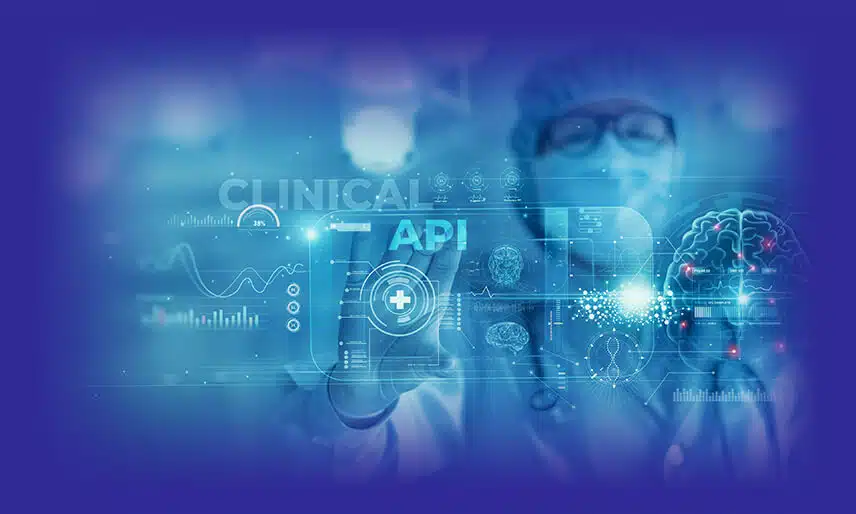
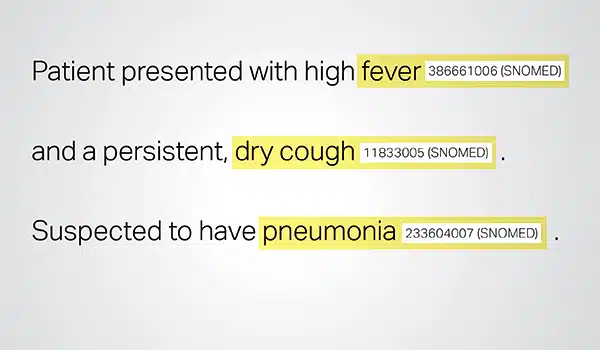
SnoMed CT
The SNOMED CT API is an advanced tool that identifies potential medical concepts as entities and associates them with the standardized codes from the Systematized Nomenclature of Medicine, Clinical Terms (SNOMED-CT) ontology. The SNOMED CT API allows for more consistent and accurate communication of medical information across different systems and stakeholders, thereby enhancing patient care, research, and data analytics.
It focuses on discerning entities in the following categories:
- MEDICAL_CONDITION: This includes the signs, symptoms, and diagnoses associated with various medical conditions. By mapping these conditions to standardized SNOMED CT codes, the API allows for more precise and comprehensive recording of patient symptoms and diagnoses, facilitating more accurate data exchange, and enabling better patient care and health outcomes.
- ANATOMY: The API also identifies and categorizes parts of the body or body systems and the locations of those parts or systems. This feature aids in the detailed mapping of patient anatomy, which is critical for procedures like surgeries, diagnosis, and other treatments. The anatomical terms and their associated SNOMED CT codes are universally understood, ensuring consistency across healthcare systems.
- TEST_TREATMENT_PROCEDURE: This pertains to various procedures, tests, and treatments utilized for the diagnosis, management, or mitigation of medical conditions. By linking these procedures to the standardized SNOMED CT codes, the API promotes a more detailed, structured, and consistent recording of patient care activities.
RxNorm
RxNorm is a standardized nomenclature for clinical drugs and drug delivery devices, developed and regulated by the U.S. National Library of Medicine (NLM). It provides unique identifiers (RxCUIs) for medication terms to enable efficient, reliable communication of medication information across different software systems & platforms.
In essence, RxNorm serves as a bridge between different terminologies for the same concept, making it possible to translate between the various “languages” used by different drug databases.
Categories that RxNorm typically handles include:
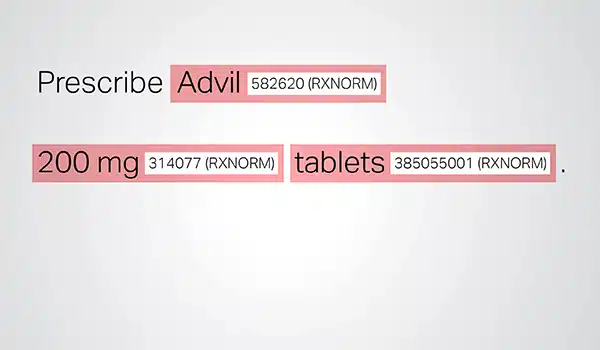
- RxNorm category: It identifies & categorizes entities under the MEDICATION category. It not only detects the entities but also their associated info classified as attributes or characteristics.
- RxNorm types: Types of Entities in the Medication Category:
- BRAND_NAME: This refers to the trademarked name given to a medication or therapeutic agent by its manufacturer. For example, “Advil” is a brand name for Ibuprofen.
- GENERIC_NAME: This is the non-proprietary name of the medication, often referring to the main ingredient or the chemical composition of the drug. i.e., “Ibuprofen”.
- RxNorm traits
- NEGATION: reference suggesting that the patient not currently taking a detected medication.
- PAST_HISTORY: indication that the patient had taken the medication in the past, prior to current medical encounter.
- RxNorm attributes
- DOSAGE: prescribed amount of the medication that the patient should take.
- DURATION: length of time over which the medication should be taken.
- FORM: physical form of the medication, such as a tablet, capsule, liquid, etc.
- FREQUENCY: how often the medication should be administered.
- RATE: indicates the speed at which the medication should be administered (for infusions or intravenous medications).
- ROUTE_OR_MODE: how the medication should be administered, i.e., orally, intravenously, etc.
- STRENGTH: concentration of the active ingredient and its strength. i.e., “200 mg” for an Ibuprofen tablet.
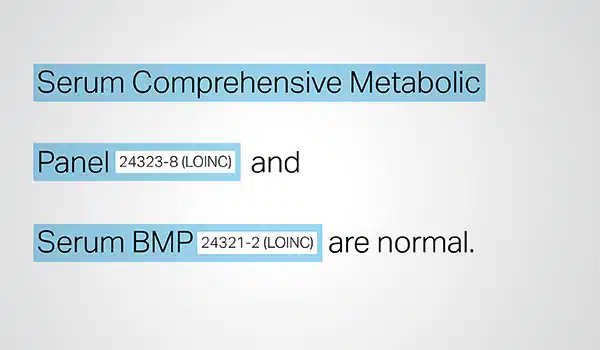
Logical Observation Identifiers Names & Codes (Loinc)
Clinical API that inspects laboratory test orders and results. Unlock medical laboratory observations for identifiers, names and codes using our NLP.
LOINC is a system for identifying health measurements, observations, and documents. The LOINC API is an interface that allows for interaction with the LOINC database, enabling applications to search and retrieve LOINC codes and their associated information. Key categories in LOINC include:
- LABORATORY_TEST: This refers to any laboratory measurement or observation, ranging from a simple blood glucose test to complex genetic testing. LOINC provides unique identifiers for each of these tests.
- CLINICAL_REPORTS: These are documents like pathology reports, discharge summaries, or radiology reports. LOINC assigns unique identifiers to these types of reports, enabling their recognition and handling across different systems.
- OBSERVATIONS: These represent measurements or simple observations related to a patient. For instance, body temperature, heart rate, or patient’s mood. Each of these observations has a unique LOINC code.
- SURVEYS: LOINC also covers surveys and questionnaires, which are frequently used in research and patient-reported outcome measures.
ICD-10-CM
Highly accurate API for medical coding that extracts billable ICD-10-CM and PCS codes from patient encounter documents at the click of a button.
The International Classification of Diseases, Tenth Edition (ICD-10), is a coding system developed by the World Health Organization (WHO) for the classification of medical conditions and procedures. It provides a common language that allows healthcare professionals to share and understand patient data across different healthcare systems and platforms. Key categories in ICD-10 include:
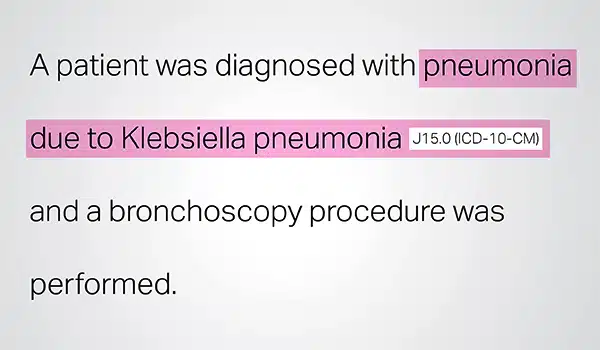
- ICD-10 category: It identifies and categorizes entities under the MEDICATION category. It not only detects the entities but also their associated info classified as attributes or characteristics.
- ICD-10-CM attributes:
- DIRECTION: Terms indicating orientation – left, right, medial, lateral, upper, lower, posterior, anterior, distal, proximal, contralateral, bilateral, ipsilateral, dorsal, or ventral.
- SYSTEM_ORGAN_SITE: The anatomical location associated with the medical condition.
- ACUITY: Characterization of the onset or duration of a disease, i.e., chronic, acute, sudden, persistent, or gradual.
- QUALITY: Any descriptive attribute of the medical condition, such as its stage or grade.
- Time Expression Category: The TIME_EXPRESSION category captures entities associated with time, including dates and time-related expressions such as “three days ago,” “today,” “currently,” “day of admission,” “last month,” or “16 days.”
- ICD-10-CM traits:
- DIAGNOSIS: A recognition of a medical condition based on an evaluation of symptoms. They can range from common conditions like hypertension (I10) to Type 2 diabetes with diabetic peripheral angiopathy (E11.51).
- HYPOTHETICAL: A reference indicating that a medical condition is stated as a possibility or supposition.
- LOW_CONFIDENCE: A reference suggesting that a medical condition has been mentioned with significant uncertainty.
- NEGATION: A sign that a medical condition is absent.
- PERTAINS_TO_FAMILY: An indication that a medical condition is associated with the patient’s family, rather than the patient themselves.
- SIGN: A medical condition as reported by the doctor.
- SYMPTOM: A medical condition as reported by the patient.
- PROCEDURES: This includes codes for surgical, therapeutic, and diagnostic procedures.





Named Entity Recognition (NER)
Clinical NER API identifies and extracts medical entities, its context and relationship from large chunks of unstructured clinical data using Deep Learning NLP Models. In the context of healthcare, the API can accurately detect and categorize words or phrases in a text that represent medically significant information.
Categories typically detected by the Medical NER API may include:
- MEDICAL_CONDITION: Identifies diseases, injuries, symptoms, or any health complaints.
- MEDICATION: Names of drugs, treatments, or other therapeutic substances.
- ANATOMY: Terms related to body parts, organs, or anatomical structures.
- PROCEDURE: Identifies medical interventions, tests, or operations.
- TEST_RESULT: Highlights outcomes or results from medical tests.
- PERSON: Identifies individuals involved in the patient’s care or personal life.
- TIME: Identifies time-related references, such as durations, frequencies, or specific dates.
PHI Redaction
The PHI (Protected Health Information) Redaction API is a system designed to identify and remove personally identifiable information or direct identifiers from health records, such as names, contact details, medical IDs, age, profession, and other personal details. This technology is used to maintain patient confidentiality and comply with Health Insurance Portability and Accountability Act (HIPAA).
The following PHI-related entities can be detected:
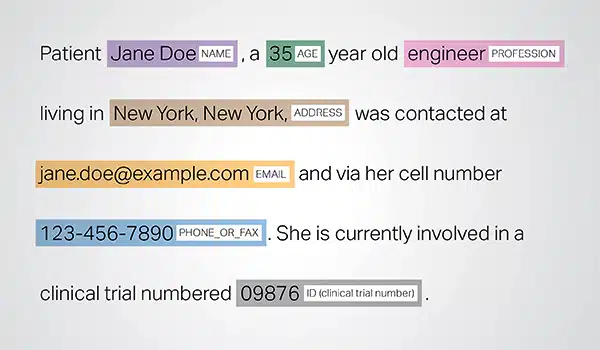
- AGE: Incorporates all elements of age, including age ranges and any mentioned ages, whether they belong to the patient, family members, or others included in the medical note.
- DATE: Any date related to the patient or their healthcare.
- NAME: All names found in the clinical note, usually pertaining to the patient, their family, or the healthcare provider.
- PHONE_OR_FAX: Any telecommunication devices i.e., phone, fax, or pager nos; however, this does not include identifiable no’s like 1-800-QUIT-NOW or emergency numbers such as 911.
- EMAIL: Any given email addresses.
- ADDRESS: Includes all geographic subdivisions of an address of any medical facility, named medical facilities etc.
- ID: Any type of number linked to the patient’s identity. This encompasses ssn, medical record numbers, facility ID numbers, clinical trial numbers, license numbers, and vehicle or device numbers. It also covers biometric identifiers etc.
- PROFESSION: Includes any profession or employer details mentioned in the note, relating to the patient or the patient’s family.
- HIPAA Category: Includes Name, Geographic location, Dates related to an individual, Phone number, FAX number, Email addresses, Social Security Number, Medical Record number, Health Plan number, Account numbers, Certificate/License numbers, Vehicle identifiers, Biometric information & Any other identifying characteristics
Custom Healthcare
A Solution as Unique as Your Needs.
In the vast field of healthcare, unique challenges demand unique solutions. That’s why at Shaip, we offer Custom Healthcare APIs, designed specifically for your distinct requirements, whether that means modifying an existing API or developing a new one from the ground up.
With our guidance, you can create specialized models tailored to your specific use cases. Whether it’s disease prediction, medical coding, adverse event detection, or any other healthcare application.
Embrace customization and reimagine healthcare with us!

With our Custom Healthcare APIs, benefit from personalized functionalities that target your specific needs, improving data management, decision-making, and patient outcomes. Share your specific requirements with us, and let our team create a tailor-made API solution that perfectly aligns with your organization’s unique needs.